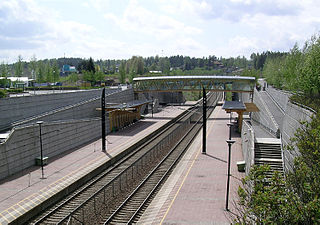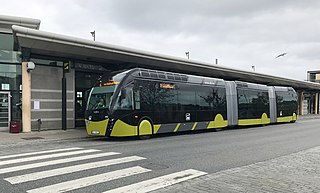Flytoget is a high-speed airport railway service connecting Oslo Airport to Oslo Central Station. Run by Flytoget AS, it operates on the high-speed Gardermoen Line using sixteen GMB Class 71 electric trains. Normal service frequency is once every ten minutes, with five of the services each hour continuing westwards beyond Oslo Central. The journey takes nineteen minutes, with extended services serving nine stops within Greater Oslo and taking up to 60 minutes.

Vygruppen, branded as Vy, formerly the Norwegian State Railways, is a government-owned railway company which operates most passenger train services and many bus services in Norway. The company is owned by the Norwegian Ministry of Transport. Its sub-brands include Vy Buss coach services, CargoNet freight trains and the Swedish train transport company Tågkompaniet. In 2009, NSB carried 52 million train passengers and 104 million bus passengers. On 24 April 2019, passenger train and bus services were rebranded as Vy.

The Bergen Line, or the Bergen Railway, is a 371-kilometre (231 mi) long scenic standard gauge railway line between Bergen and Hønefoss, Norway. The name is often applied to the entire route from Bergen to Oslo, including the Randsfjord and Drammen lines between Hønefoss and Oslo, covering a total distance of 496 kilometres (308 mi). It is the highest mainline railway line in Northern Europe, crossing the Hardangervidda plateau at 1,237 metres (4,058 ft) above sea level.

The Gardermoen Line is a high-speed railway line between Oslo and Eidsvoll, Norway, running past Lillestrøm and Oslo Airport, Gardermoen. The line is 64 kilometres (40 mi) long and replaced the older Hoved Line as the main line north-east of Oslo. The older Hoved Line now handles commuter and freight traffic, while the Gardermoen Line handles high-speed passenger trains and freight trains laden with jet fuel for the airport. Both lines are owned by Bane NOR.

NSB Class 71 is an electric multiple unit used by Flytoget for the Airport Express Trains on the Gardermoen Line of Norway. Sixteen three-car train sets were built by Adtranz Strømmen between 1997 and 1998. The units are capable of 210 km/h (130 mph), connecting Oslo Central Station and other stations in Metropolitan Oslo to the Oslo Airport, Gardermoen, along Norway's only high-speed railway.

Vy Buss, formerly branded as Nettbuss, is the largest bus company in Norway, owned by Vy. It was established on 10 February 2000 as the continuation of the bus operations from former NSB Biltrafikk. In addition to bus services in major parts of Norway, it also operates buses in Sweden through subsidiaries.

Vy Gjøvikbanen AS is a Norwegian railway company that operates the passenger train service on the Gjøvik Line. A subsidiary of the state-owned Vy, it operates a fleet of nine Class 69g three-car electric multiple units. NSB Gjøvikbanen provides two different services: the Skøyen – Oslo S – Jaren service is part of the Oslo Commuter Rail; while Oslo S – Gjøvik is a regional service, with only limited stops on the route until Grua. Departures are each 40 minutes, with every third train running to Gjøvik.

Trondheim Central Station or Trondheim S is the main railway station serving the city of Trondheim, Norway. Located at Brattøra in the north part of the city centre, it is the terminus of the Dovre Line, running southwards, and the Nordland Line, which runs north. The railway is electrified south of the station but not north of it, so through trains must change locomotives at the station.

Trondheim Sporvei was a municipally owned tram operator in Trondheim, Norway that existed between 1936 and 1974. The company operated the municipal parts of the Trondheim Tramway until it was merged with A/S Graakalbanen and Trondheim Bilruter to create Trondheim Trafikkselskap. That company has become part of Nettbuss, the largest Norwegian bus company in Norway which is owned by Norwegian State Railways.

LKAB Malmtrafik, earlier Malmtrafik i Kiruna AB (MTAB), is a Swedish railway company which operates the iron ore freight trains on the Iron Ore Line and the Ofoten Line. MTAB is a wholly owned subsidiary of the mining company Luossavaara–Kiirunavaara (LKAB). In Norway, operations are handled by the subsidiary Malmtrafikk AS (MTAS). Malmtrafik hauls ore from LKAB's mines in Kiruna, Malmberget and Svappavaara to the ports of Luleå and Narvik, the latter located in Norway. The company owns 28 Iore locomotives and 750 hopper cars. Each train is 68 cars long and weighs 8,600 tonnes, allowing the company to transport 33 million tonnes per year.
BaneService is a Norwegian government owned railway construction and maintenance company. It is by far the largest subcontractor for Bane NOR and is owned by the Norwegian Ministry of Transport and Communications.

Arrive was a Norwegian information technology company owned by Norges Statsbaner that offers a wide range of Information Technology services, primarily targeting the railway and public transport sector, with the NSB corporation being the dominant customer. The company has 70 employees, is based in Oslo and was created in 2001 as a limited company, though had been a separate division within NSB since 1970.

The Horten Line was a 7.0-kilometer (4.3 mi) branch railway line of the Vestfold Line which ran from Skoppum to Horten, Norway. The line opened as a narrow gauge line on 13 October 1881, the same day as the Vestfold Line. The latter had been proposed to run through Horten, but instead a branch line was chosen. The Horten Line converted to standard gauge in 1949 and electrified in 1957. Passenger transport ran until 1968 and freight trains until 2002. The line was demolished in 2009 and converted into a combined walking and bicycle path. Skoppum Station and Borre Station have both been preserved as examples of Balthazar Lange's Swiss chalet style architecture.

Ruter AS is the public transport authority for Oslo and Akershus counties in Norway. Formally a limited company – 60% of its shares are owned by the Oslo county municipality and 40% by that of Akershus – it is responsible for the administration, funding, and marketing of public transport in the two counties, including buses, the Oslo Metro, Oslo Trams, and ferry services. Ruter also holds agreements with Entur concerning the regulation of fares on local and regional train services operated within the two counties.
Osmund Ueland is a Norwegian civil servant and former CEO of Norges Statsbaner (NSB).
Skabo Jernbanevognfabrikk was a mechanical workshop focusing on design and construction of railcars. It was established by Hans Skabo in Drammen, Norway, in 1864; it became the first rail car factory in the country when it took delivery of the cars for Kongsvingerbanen. Due to the size of the venture, it moved to Tyskerstranden at Skøyen in Kristiania in 1873.

The Norwegian Union of Railway Workers is a trade union in Norway. It was formed on 20 November 1892, and mainly organizes workers in Norges Statsbaner—with the exception of locomotive drivers— and the Norwegian National Rail Administration, including related companies such as BaneTele, Nettbuss, Nettlast, Malmtrafik, MiTrans, Mantena, Trafikkservice, CargoNet, Baneservice, Arrive, Ofotbanen AS, NSB Gjøvikbanen and Flytoget.

Horten Station is a former railway station in Horten, Norway, which was the terminus of the Horten Line and in use between 1881 and 1967. The station was designed in Swiss chalet style by Balthazar Lange and was wedged between the town and the Oslofjord. It was located 106.51 kilometers (66.18 mi) from Oslo.

The Norwegian State Railways was a state-owned railway company that operated most of the railway network in Norway. The government agency/directorate was created in 1883 to oversee the construction and operation of all state-owned railways in Norway. On 1 December 1996, it was demerged to create the infrastructure operator Norwegian National Rail Administration, the train operator Norwegian State Railways and the Norwegian Railway Inspectorate. The name was taken by the train operator, although the infrastructure operator remained a government agency and is the legal successor.

AtB AS is a public transport manager for Trøndelag county and is managed as a corporation. AtB's task is to plan, order, market and develop public transport in the county. Tariffs are set by the county council as part of the budget process. AtB has three main sources of funding: Ticket revenues, grants from the Trøndelag County Municipality and the Environmental Package. AtB has a customer center at Prinsens Gate 41 right beside the bus stop Prinsens Gate P2 in Trondheim. AtB took over as public transport manager for bus traffic in Trondheim in 2010, tram traffic on Gråkallbanen and other bus traffic in Sør-Trøndelag county in 2011, speedboat routes in 2012 and 2014, ferries in 2015, and in 2018, the former Nord-Trøndelag county was also incorporated after the two counties was merged into the new county of Trøndelag.















